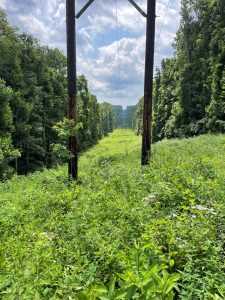Two years ago, Hoosier Energy became the first generation and transmission cooperative to receive a Certificate of Inclusion for the U.S. Fish and Wildlife Service Nationwide Candidate Conservation Agree with Assurances (CCAA) for the monarch butterfly.
That commitment to integrated vegetation management and the practices encouraging habitat maintenance and development continues to reap benefits.
This summer, Hoosier Energy was one of 11 utilities awarded a grant from the Pollinate Program at the University of Illinois-Chicago’s Energy Resources Center. The $10,000 award will aid in the development of an integrated vegetation management plan to maintain pollinator habitat on rights-of-way within the Hoosier National Forest.
It sounds simple enough, but the Monarch CCAA tied all the moving pieces together.
The project dates back to late 2021 when Hoosier Energy approached Hoosier National Forest about the possibility of using herbicidal spray to control incompatible, woody-stemmed vegetation within the rights-of-way instead of mowing and, in some cases, hand-cutting brush.
“Not being able to use herbicide is problematic for many different reasons,” said Jared Murphy, Hoosier Energy Vegetation Management Coordinator. “When you cut brush or mow it, it sprouts back from the stub and grows vigorously towards our lines. And when you cut one stem, it will sprout back with a dozen more stems in a bushy pattern, so it comes back faster with higher growth rates. It’s thicker, so it’s harder to walk through if our linemen are trying to get in to fix an outage.”
Last year, a pair of fires along the rights-of-way highlighted another risk of having brush piles that can serve as fuel for the fire.
On the other hand, the benefits of being able to spray, as Hoosier does on the rest of its system, are significant.
“If we go in and spray, not only will it give us better control and better access for line restoration, but it’s going to help convert the rights-of-way from mostly woody, thick growth to a more prairie-type habitat with grasses and wildflowers and things that are beneficial for all different species,” Murphy said. “The pollinators especially love it, the deer love it, all kinds of wildlife that they want to see in the forest will use these rights-of-way and be beneficial for us, for the environment, for the public and everyone involved.”

This photo shows the progress of a pollinator habitat planted in the Hoosier National Forest right-of-way.
With the Monarch CCAA in hand in 2022, Hoosier Energy began to file the paperwork necessary to revise its permit with Hoosier National Forest to allow the use of herbicides.
After going through local and regional levels, the request headed to Washington, D.C., where the decision was made that Hoosier Energy qualified for a categorical exclusion of “collaborative effort” with Hoosier National Forest for habitat development thanks to the Monarch CCAA.
“If we had gone through the normal process and not been involved in the Monarch CCAA, we would have been tasked with performing a full environmental assessment, which would have cost us thousands of dollars and taken well over a year, year and a half to get approved through the National Environmental Protection Agency (NEPA) process,” said Dave Appel, Hoosier Energy Environmental Team Lead. “It was the first time that categorical exclusion had been used in this type of scenario. It was a landmark decision Washington came up with, and Evie Phelps from the local forest service office went to bat on our behalf. It’s a leading issue for other utilities, who are waiting to see how this comes together because we are the first entity to go through this process.”
The paperwork is ongoing with hopes of a final resolution in late 2024, but as this process was taking place, the opportunity to apply for the Pollinate Program award came up.
It wasn’t something that had been on the radar at all, but as soon as he heard about it, Murphy was filling out the grant application.
“I wrote up a summary of the process we’re going through with Hoosier National Forest to update the permit and trying to develop pollinator habitat and maintain that habitat,” he said. “We applied for the max amount of $10,000 since we’ve already spent that much in seed alone for a 10-acre stretch of right-of-way just east of Hemlock Cliffs in English.”
The goal is to use the grant money to further develop new habitats as well as maintain ones already seeded. Murphy recently met with biologists from Pheasants Forever and Quail Forever at potential sites to develop further habitats.
It’s further proof that the Monarch CCAA was a worthwhile investment.
“This is a big win for Hoosier Energy,” Appel said. “As the first co-op G&T in the country to enter into this agreement, we are seeing so many benefits to our enrollment.”